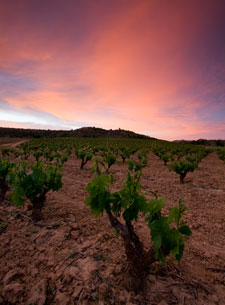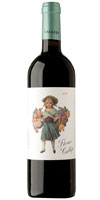An argument can be made that Spain’s finest quality grape of Tempranillo finds its most singular and possibly greatest expression in the Ribera del Duero district of the north’s Castilla y Léon. The great and better-known wines of Rioja are typically blended with Garnacha and other grapes; far less blending with Cabernet Sauvignon, Merlot, and Garnacha takes place in Ribera del Duero with a hot topic amongst growers whether or not to add Syrah to this list
The region encompasses 60 villages along the 50×15 miles of the Duero River in north central Spain. As it flows west across the border into Portugal, it’s known as ‘Douro’, synonymous with the country’s Ports and most of its finest dry reds. Sun abounds and the climate is hot and dry for much of the year, with approximately 20 inches of rain falling in the cold winter months. Most vineyards are planted at around 2,200-2,800 foot elevation and vary from valley floor to moderately steep slopes. Spring frosts occur with regularity, further insuring against high yields. Moderately heterogeneous soils of silt, clay, sand, limestone, and marl form the basis of the landscape. It’s not uncommon to find vineyards in this regularly torrid region planted in a northern orientation so as to minimize unwanted effects from too much sun. The denomination has grown in the last 20 years from 42 to over 200 wineries, with its westernmost outpost of Quintanilla de Onésimo one of the world’s most charming wine villages.
Quintanilla de Onésimo’s Posada Fuente de la Aceña, converted many years ago from its original use as a mill, is situated gracefullyalongside a spillway on the southern bank of the lazy river adjacent to one of the few bridges crossing it. Its dining room is perched in the trees with a bird’s-eye view to the river, taking advantage of the natural light from all directions but the brutal south. Lunch or dinner can be enjoyed off the same menu but don’t miss the lima beans with pig’s ears in broth. My seasonal albondigas de ciervo con setas (minced deer meatballs with finely chopped potatoes and tiny mushrooms in a thick, veal reduction sauce) was both warming without being too filling for a brisk early spring day. Washed down with a bottle of locally-made Lynus Aurea, it made for a lovely siesta segue.
Next up, we take a trip to the wineries.
[ pagebreak ]
Now run by a brother and three sisters, the aviation enthusiast Félix Callejo‘s family estate has rapidly grown to be one of the most visible Ribera estates in the U.S. due to the efforts of eldest sister Cristina. After completing a stint at Bordeaux’s famous Petrus estate, winemaker José-Félix set about expanding and improving his family’s vineyards near their Sotillo village home with the results justifiying the Callejos’s ongoing success.
One of my more memorable Quintanilla de Onésimo visits in years past was with Monica and Rubén Iglesias Barredo of the winery Vega de Yuso, where the Barredos showed me a 15th century stone cold storage cellar in their courtyard which they’ve since renovated. But the region’s mainstay is Vega Sicilia, a very short 5 kilometer drive east on the district’s major artery of the N122. Vega refers to the surrounding mountains, Sicilia to a woman’s name. Originally established by a medieval marquesa, Vega Sicilia was only developed as a wine estate in 1864. At this time, France was the undisputed model for great wines. Spain’s northern neighbor was also the source for a diverse collection of grape vine cuttings that were amassed by the owner in a personal visit to the great vineyards of Bordeaux and Burgundy, cuttings that would form the basis of what continues today as the winery’s one acre mother vineyard. This living enological museum is a tiny piece of its 2400-acre estate.
Natasja Mallory of Gregory White PR, charged with promoting Ribera wines in the US, told me that “Ribera del Duero constitutes a valuable part of Spain’s red wines, and needn’t only go with Spanish food.”
Next up, our picks for the best Ribera wine, in every price range.
[ pagebreak ]For your at-home enjoyment, we offer the following selections:
Callejo ‘Flores de Callejo’ Roble 2011, $20. Lighter, more accessible style of Ribera wine. Lends an easy introduction into Tempranillo.
Arzuaga ‘Arzuaga’ Crianza 2009, $25. Aromas of vanilla and raspberry, a palate of refreshing acidity and tannins.
Vega de Yuso ‘Tres Matas’ Crianza 2009, $25. Named for three historic trees brimming upon a hilltop above the village.
Valsotillo Crianza 2009, $30. Great depth of earth, leather character, and elegant tannins.
Aalto ‘PS’ 2008, $100. Seamless, old-vine poise, made by talented winemaker Javier Zuccagnini.
Vega Sicila ‘Unico’ 1995, $400. The region’s benchmark, displaying smoke, earth, plum aromas; a full body with moderate tannins, currant, blackberry, and clove flavors on a concentrated palate.
For more information about wine tourism in Ribera del Duero, visit Drink Ribera. Drink Spain. or Ruta del Vino de la Ribera del Duero.



![Making Mealtime Matter with La Familia: Easy Sofrito [Video]](https://thelatinkitchen.com/wp-content/uploads/2015/10/sofrito-shutterstock__0-500x383.jpg)
![Easy Latin Smoothies: Goji Berry Smoothie [Video]](https://thelatinkitchen.com/wp-content/uploads/2015/12/goji_berry-shutterstock_-500x383.jpg)
















![Fun and Fast Recipes: Fiesta Cabbage Salad [Video]](https://thelatinkitchen.com/wp-content/uploads/2015/11/fiesta_cabbage_slaw-shutterstock_-500x383.jpg)









